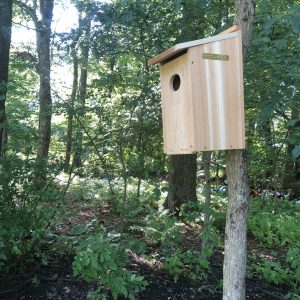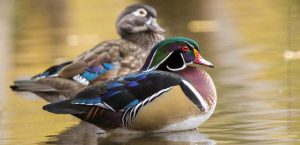This wood duck nesting box was put up last week at the Hupper Preserve pond on the GreenLink Trail between Irwin Park and the New Canaan Nature Center. A second wood duck box was installed at the Smith Preserve overlooking Jelliff Mill Pond. Both were donated by Jim Webster in memory of his sister, Sally Keller, who was an avid birdwatcher with New Canaan Audubon. The gift also included 5 bluebird type nesting boxes which were installed recently by our summer interns on various NCLT preserves.

Wood ducks nest in natural tree cavities or holes excavated by woodpeckers. They don’t bring in nesting materials but rely on wood pulp and debris found naturally in their chosen site. Because our bird boxes are man-made, we have added a thick layer of clean wood chips to encourage a mama duck to take up residence.
Wood ducks raise 2 broods with 6-12 ducklings per brood per year. Many predators, including raccoons, minks, snakes, snapping turtles, bull frogs and fish prey on wood ducks eggs and ducklings. Therefore, the ducks produce large numbers of eggs to compensate for the low survival rate of their young.
In order to find food, the ducklings must fledge the nest within a day or so of hatching. (mother ducks do not feed their young but teach them how to forage for themselves). The mother leaves the nest, flies to the ground and calls to her young. The hatchlings, unable to fly at this stage, must jump to join her. As mom calls incessantly, the ducklings muster courage and leap, one-by-one, tumbling to the ground below. Sometimes it is a long, long way down. They have been known to jump from a height of 50 feet!
Wood ducks are omnivores. The young dine primarily on insects, while the adults eat a cornucopia of acorns, seeds, algae and aquatic plants, butterflies and moths, slugs, snails, ants and beetles.

Recent Comments